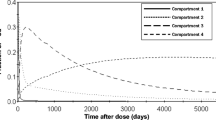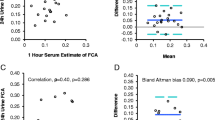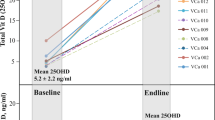Abstract
Summary
Urinary excretion of calcium tracers in labeled individuals decreases in response to antiresorptive therapy, providing a tool to rapidly screen potential therapies. Using teriparatide, we demonstrate in this study that anabolic therapy also decreases tracer excretion, confirming that this method can also be used to screen potential anabolic therapies.
Introduction
Changes in urinary excretion of calcium tracers from a labeled skeleton may be a rapid and sensitive method to screen potential therapies for osteoporosis. This method has been used to screen antiresorptive therapies, but the effect of anabolic therapies on tracer excretion is unknown.
Methods
Eight-month-old female Sprague Dawley rats (n = 11) were given 50 μCi 45Ca iv. After a 1-month equilibration period, baseline urinary 45Ca excretion and total bone mineral content (BMC) were measured. Rats were then treated with 30 μg/kg teriparatide sc per day, a bone anabolic agent, for 80 days. Urine was collected throughout the study and analyzed for 45Ca and total Ca, and BMC was measured at the beginning and end of the study.
Results
Teriparatide decreased urinary 45Ca excretion by 52.1 % and increased BMC by 21.7 %. The change in bone calcium retention as determined by the ratio of 45Ca to total Ca excretion in urine from day 6 through 15 of teriparatide treatment was significantly correlated (p = 0.036) with the change in BMC after 80 days of teriparatide treatment.
Conclusion
Urinary excretion of calcium tracers from labeled bone is an effective method to rapidly screen potential anabolic therapies for osteoporosis.


Similar content being viewed by others
References
Chen P, Satterwhite JH, Licata AA, Lewiecki EM, Sipos AA, Misurski DM, Wagman RB (2005) Early changes in biochemical markers of bone formation predict BMD response to teriparatide in postmenopausal women with osteoporosis. J Bone Miner Res 20:962–970
Ravn P, Hosking D, Thompson D, Cizza G, Wasnich RD, McClung M, Yates AJ, Bjarnason NH, Christiansen C (1999) Monitoring of alendronate treatment and prediction of effect on bone mass by biochemical markers in the early postmenopausal intervention cohort study. J Clin Endocrinol Metab 84:2363–2368
Seibel MJ (2005) Biochemical markers of bone turnover part I: biochemistry and variability. Clin Biochem Rev 26:97–122
Seibel MJ, Lang M, Geilenkeuser WJ (2001) Interlaboratory variation of biochemical markers of bone turnover. Clin Chem 47:1443–1450
Wastney ME, Ng J, Smith D, Martin BR, Peacock M, Weaver CM (1996) Differences in calcium kinetics between adolescent girls and young women. Am J Physiol 271:R208–R216
Hansen JW, Gordan GS, Prussin SG (1973) Direct measurement of osteolysis in man. J Clin Invest 52:304–315
Muhlbauer RC, Fleisch H (1990) A method for continual monitoring of bone resorption in rats: evidence for a diurnal rhythm. Am J Physiol Regul Integr Comp Physiol 259:679–689
Klein L, Van Jackman K (1976) Assay of bone resorption in vivo with 3H-tetracycline. Calcif Tiss Res 20:275–290
Klein L (1980) Direct measurement of bone resorption and calcium conservation during vitamin D deficiency or hypervitaminosis D. Proc Natl Acad Sci U S A 77:1818–1822
Jackson GS, Weaver CM, Elmore D (2001) Use of accelerator mass spectrometry for studies in nutrition. Nutr Res Rev 14:153–157
Stewart DJ (1973) The re-incorporation in calcified tissues of tetracycline released following its deposition in the bones of rats. Arch Oral Biol 18:759–764
Zhao Y, Cheong JMK, Lee WH, Wastney M, Martin BR, Weaver CM (2010) Tetracycline and calcium kinetics are comparable for estimating bone resorption in rats. J Nutr 140:1704–1709
Cheong JMK, Gunaratna NS, McCabe GP, Jackson GS, Weaver CM (2009) Bone seeking labels as markers for bone turnover: effect of dosing schedule on labeling various bone sites in rats. Calcif Tissue Int 85:444–450
Zhou X, Zhang P, Zhang C, An B, Zhu Z (2010) Tetracyclines inhibit rat osteoclast formation and activity in vitro and affect bone turnover in young rats in vivo. Calcif Tissue Int 86:163–171
Weaver CM, Martin BR, Jackson GS, McCabe GP, Nolan JR, McCabe LD, Barnes S, Reinwald S, Boris ME, Peacock M (2009) Antiresorptive effects of phytoestrogens supplements compared with estradiol or risedronate in postmenopausal women using 41Ca methodology. J Clin Endocrinol Metab 94:3798–3805
Lee WH, Wastney ME, Jackson GS, Martin BR, Weaver C (2011) Interpretation of 41Ca data using compartmental modeling in post-menopausal women. Anal Bioanal Chem 399:1613–1622
Girotra M, Rubin MR, Bilezikian JP (2006) The use of parathyroid hormone in the treatment of osteoporosis. Rev Endocrinol Metab Disord 7:113–121
Sato M, Vahle J, Schmidt A, Westmore M, Smith S, Rowley E, Ma YL (2002) Abnormal bone architecture and biomechanical properties with near-lifetime treatment of rats with PTH. Endocrinol 143:3230–3242
Cheong JMK, Gunaratna NS, McCabe GP, Jackson GS, Kempa-Steczko A, Weaver CM (2011) Bone-seeking labels as markers for bone turnover: validation of urinary excretion in rats. Osteoporos Int 22:153–157
Miller PD, Bilezikian JP, Diaz-Curiel M, Chen P, Marin F, Krege JH, Wong M, Marcus R (2007) Occurrence of hypercalciuria in patients with osteoporosis treated with teriparatide. J Clin Endocrinol Metab 92:3535–3541
Toromanoff A, Ammann P, Mosekilde L, Thomsen JS, Riond JL (1997) Parathyroid hormone increases bone formation and improves mineral balance in vitamin D-deficient female rats. Endocrinol 138:2449–2457
Glover SJ, Eastell R, McCloskey EV, Rogers A, Garnero P, Lowery J, Belleli R, Wright TM, John MR (2009) Rapid and robust response of biochemical markers of bone formation to teriparatide therapy. Bone 45:1053–1058
Mitlak BH, Schoenfeld D, Neer RM (1994) Accuracy, precision, and utility of spine and whole-skeleton mineral measurements by DXA in rats. J Bone Miner Res 9:119–126
Acknowledgements
We thank Eli Lilly and Company for providing the teriparatide used in this experiment. We also thank Pamela Lachcik and Ania Kempa-Steczko for technical assistance.
Conflicts of interest
Connie M. Weaver serves on boards for the National Osteoporosis Foundation, the International Life Sciences Institute, Showalter, and Pharmavite and receives research funding from NIH, Dairy Research Institute, Nestle, and Tate and Lyle. Emily E. Hohman, George P. McCabe, and Munro Peacock declare that they have no conflict of interest.
Author information
Authors and Affiliations
Corresponding author
Rights and permissions
About this article
Cite this article
Hohman, E.E., McCabe, G.P., Peacock, M. et al. Validation of urinary calcium isotope excretion from bone for screening anabolic therapies for osteoporosis. Osteoporos Int 25, 2471–2475 (2014). https://doi.org/10.1007/s00198-014-2790-6
Received:
Accepted:
Published:
Issue Date:
DOI: https://doi.org/10.1007/s00198-014-2790-6




